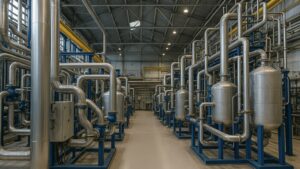Did you know? The energy application centre for data centres is projected to consume more than 8 billion dollars this year. Further, a recent Uptime Institute survey of data centre operators globally found that merely 27% measure their environmental impact. So, it indicates much work lies ahead to curb runaway growth in consumption. However, pioneering facilities worldwide have shown that ambitious energy efficiency is possible today. This is while delivering business, social, and environmental value.
This article explores seven real-world case studies of successful energy reduction initiatives from European, Asian, and North American operators. They are the ones that have created replicable templates for sustainability. The featured initiatives encompass cooling system optimization, waste heat reuse, onsite power generation, workload management automation, and more. This is to restrict the data centre industry’s voracious power appetite. So, let’s take a deeper look.
Successful Energy Reduction Initiatives: Immersion Cooling Slashes PUE to 1.03
An American cloud services company deployed submarine-inspired immersion cooling technology. It is developed by Green Revolution Cooling across a high-density deployment of AI compute hardware in a Midwest data centre. So, by submerging server racks in custom enclosures filled with mineral oil, the facility leverages the liquid’s natural heat absorption. As a result, it eliminates chillers. Moreover, this pioneering retrofit has reduced their PUE to 1.03 while unlocking a 60% increase in compute capacity per rack.
Lesson: Immersion cooling can achieve extreme efficiencies. This is in suitable high-density hardware deployments with minimal operational disruption.
Successful Energy Reduction Initiatives: Waste Heat From Bitcoin Mining Provides District Heating
MintGreen, a Canadian Bitcoin mining and data centre operator uses patented immersion cooling and Digital Boilers. It captures all hardware waste heat from its flagship facility near Vancouver. Moreover, the reclaimed energy provides space heating to up to 5000 adjacent homes year-round. So, this reduces community GHG emissions by over 5000 tonnes annually. Additionally, a produce greenhouse situated beside the data centre also utilizes surplus heat and CO2 from the facility. This is to grow local vegetables sustainably.
Lesson: Holistic data centre site planning focused on exploiting waste heat energy can provide environmental benefits beyond computing.
Successful Energy Reduction Initiatives: Eco-Friendly Cooling Retrofit Cuts Energy Use 43%
A Tier III European wholesale colocation provider deployed hot aisle containment and targeted cooling airflow provided by EcoCooling in its legacy data halls. Furthermore, the $312,000 refit has reduced cooling energy usage by over 40% while unlocking 30% extra IT load capacity. This is within the existing power and cooling infrastructure. So, by eliminating overprovisioning with smart containment-based airflow optimization, the retrofit offers exemplary returns. It comes along with extended facility lifecycles sustainably.
Lesson: Quickly deployed modular airflow containment solutions can rapidly transform inefficient legacy facilities at a reasonable expense.
Successful Energy Reduction Initiatives: Dynamic Workload Distribution Cuts Costs
A European cloud provider uses smart automation. It helps to redistribute non-critical workloads between its six regional sustainable data centres. This is in response to renewable energy availability and dynamic electricity rates across the grid. As a result, this balanced provisioning has reduced the company’s annual electricity costs by $142 million. This is while contracting its carbon footprint by 11% last year. Moreover, the pioneered system is now being productized to offer optimization-as-a-service to geospatially distributed customers.
Lesson: Intelligent workload automation across facilities can sustainably optimize energy usage and lower expenses.
Successful Energy Reduction Initiatives: Hydroelectricity Powers a Renewable Data Centre
The Lefdal Mine Data centre, located 150 meters underground in a repurposed Norwegian mine, is entirely powered by adjacent hydroelectric plants. The facility also leverages the cavern’s consistent 15°C air. It helps to eliminate mechanical cooling with heat exchangers. So, this unique confluence of location and supply en route to delivering PUEs below 1.1.
Lesson: Access to dedicated renewables paired with passive geo-adaptive cooling provides a future-ready green solution when available.
Successful Energy Reduction Initiatives: ML Optimizes Cooling Among Interdependent Systems
Google uses neural networks trained using 120 million data points from its global data centres. It is to orchestrate cooling workflows. Moreover, the AI assistants optimize chilled water pumps, cooling towers, and airflow dynamically. It helps to reduce the energy consumed for cooling alone by 10 to 25 percent in different facilities. This initiative has also been key to lowering Google’s average PUE figure to 1.1 across global data centres spanning 15 countries.
Lesson: AI and ML offer immense potential to optimize interdependent data centre sub-systems to multiply savings holistically.
Policy Action Accelerates Energy Efficiency
Governments worldwide are also targeting data center emissions through funding, incentives, and transparency mandates. France requires operators to publicly detail energy performance. Meanwhile, Germany provides up to 70% subsidies for efficiency measures. Furthermore, the US Save Act extending similar incentives is impending, while the EU may enforce PUE reporting soon. So, such policy activism is essential to accelerate the adoption of known best practices globally.
Lesson: Intelligent regulatory support and transparency requirements can positively influence sustainability drives.
A Path Forward
While the innovations showcased above are encouraging, sustained effort is essential for successful energy reduction initiatives. It helps to restrict data centre energy use to acceptable levels amid exponential information growth. Thankfully, collaborative industry associations are actively synthesizing and propagating best practices globally to accelerate adoption.
Furthermore, governments worldwide are also commencing scrutiny. This is while providing incentives and funding for efficiency drives and research initiatives encompassing new technologies. Renewable energy uptake and smart grid integration will also likely play a key role in sustainably powering the world’s insatiable information appetite going forward.
Yet ultimately, continued innovation alongside universal measurement and transparency of operational impacts will be pivotal to steer sustainable data centres onto a sustainable path. Industry events such as the Net Zero Data Centre Summit on 1-2 February 2024 in Berlin, Germany that congregate diverse stakeholders across operations, design, and policy offer ideal platforms to actively drive the transition together through knowledge sharing. So, make sure you learn more about the event and mark your attendance!





